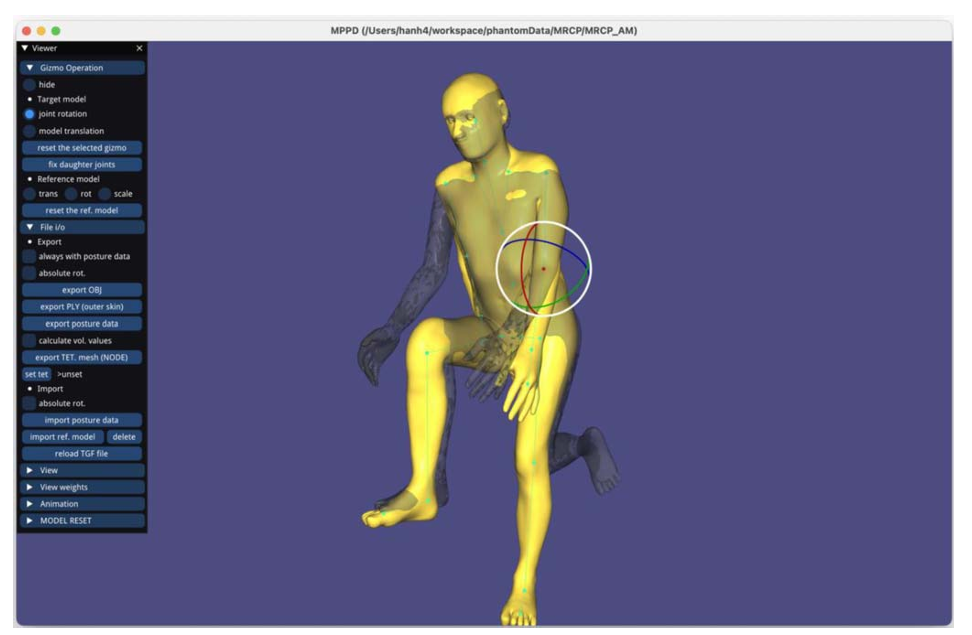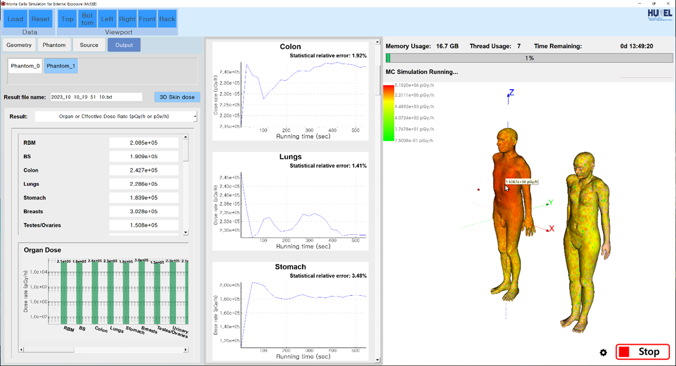
MPPD (Mesh-type Phantom Posture Deformer)
MPPD (Mesh-type Phantom Posture Deformer) is a user-friendly software designed to easily deform the posture of adult mesh-type reference computational phantoms (MRCPs) and MRCP-based library phantoms. Through its graphical user interface (GUI), users can intuitively manipulate phantom posture using a transformation gizmo, enabling real-time posture deformation such as sitting or kneeling. The program utilizes automatic rigging, bounded biharmonic weights (BBW), and dual quaternion skinning (DQS) algorithms to ensure smooth and natural mesh deformations. Phantom deformation is performed on the polygon mesh (PM) model for efficiency, and the deformed phantom can be exported in either PM or tetrahedral mesh (TM) format, with posture data also exportable as joint rotation quaternions. The exported TM phantoms are directly applicable to Monte Carlo simulation codes such as Geant4, MCNP6, and PHITS, making MPPD a powerful tool for dose assessment studies. Demonstration studies confirmed that MPPD-deformed phantoms can be used for calculating organ and detriment-weighted doses under various irradiation geometries and photon sources, with good agreement to manually deformed phantom data. MPPD enables rapid phantom deformation—typically within 20 minutes even on low-spec computers—making it a practical solution for posture-specific dosimetry research.
For more information, please contact haegin.han@nih.gov

PARaDIM (PHITS-based Application for Radionuclide Dosimetry In Meshes)
PARaDIM (Particle and Heavy Ion Transport Code System–Based Application for Radionuclide Dosimetry in Meshes) is a Monte Carlo simulation tool developed based on PHITS for performing internal dosimetry calculations using tetrahedral mesh-type computational phantoms. It supports all medically relevant radionuclides, including α, β, γ, positron, and Auger/conversion electron emitters. PARaDIM allows users to configure phantom geometry, source definitions, and simulation parameters through a graphical user interface (GUI), enabling organ-level mean absorbed doses and three-dimensional dose distributions to be calculated and visualized. It is capable of handling human, small-animal, and cell-level dose assessments, making it versatile for applications in nuclear medicine, radiopharmaceutical research, and preclinical studies. Additionally, PARaDIM supports brachytherapy and external-radionuclide exposure scenarios, and can also perform 4-dimensional dose calculations by importing dynamic geometries as separate static frames.
For more information, please contact carterl1@mskcc.org

McSEE (Monte Carlo Simulation Code for External Exposure)
McSEE (Monte Carlo Simulation code for External Exposure) is a user-friendly software developed for external dose assessment using mesh-type computational phantoms. Integrating a GUI module with a Geant4-based Monte Carlo engine, McSEE enables seamless configuration and simulation within a single platform, without requiring separate Monte Carlo tools. Unlike conventional Monte Carlo codes that require specialized scripting knowledge, McSEE offers an intuitive interface to streamline the dose assessment workflow. Users can define exposure scenarios through interactive panels for geometry, phantom, and source settings, each supporting real-time 3D visualization. The program supports a broad range of phantoms, including ICRP mesh-type reference phantoms and posture- or body-size-transformed phantoms, with optional additions such as clothing and dosimeters. Various source configurations are supported to flexibly model diverse external exposure conditions encountered in practical settings. McSEE calculates key dosimetric quantities including organ doses, effective dose, skin dose distribution, and dose equivalent, presenting results in both numerical and graphical formats during runtime. McSEE serves as a dedicated Monte Carlo dose calculation code for external exposure, enabling reliable and scenario-specific dose assessments across a broad spectrum of radiation protection and emergency response applications. McSEE is currently under development and undergoing validation, with a beta version soon to be available for user testing.

TET2DICOM (Tetrahedral-mesh-phantom to DICOM-RT Dataset)
TET2DICOM is a software that automatically converts computational human phantoms into DICOM CT and DICOM-RT Structure formats, enabling direct use in treatment planning systems (TPS). It allows the accurate importation of phantom datasets—including complex anatomical structures and various postures—into commercial clinical software such as RayStation and MIM, with volume differences of less than 0.1%. TET2DICOM generates CT images and radiotherapy structure files with high fidelity, making it suitable for applications such as organ-absorbed dose evaluation, posture-dependent dose analysis, and secondary cancer risk assessment. The program also features efficient data handling through OpenMP-based multiprocessing and supports re-use of voxelization log files to significantly reduce processing time during reconversion. As a result, TET2DICOM serves as a powerful tool for precise dose assessment and realistic treatment planning in both clinical and research settings.
For more information, please contact mchan@yuhs.ac
